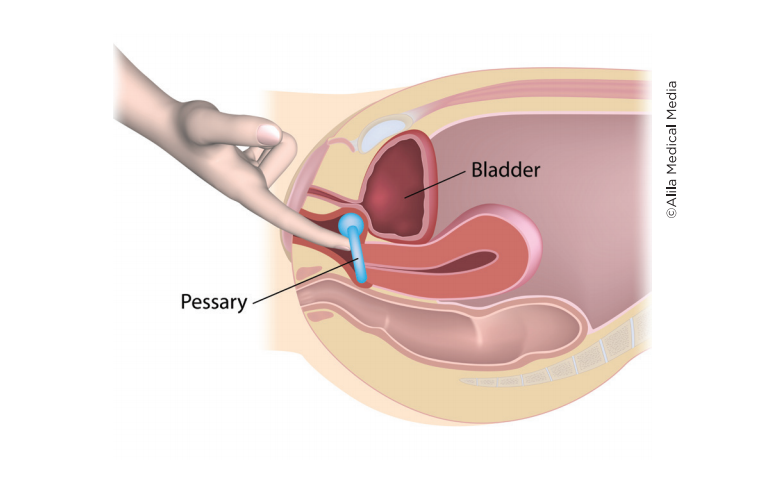A vaginal pessary is a silicone device, similar to a vaginal contraceptive diaphragm used to treat urinary incontinence and/or prolapse.
About Vaginal Pessaries
A vaginal pessary is inserted into the vagina to support dropped pelvic organs and apply compression to the urethra during activities that can cause urine leakage. For many women, pessaries are a low-risk treatment option for pelvic organ prolapse (POP) or urinary incontinence. A pessary allows you to be comfortable and active without surgery. Not all women can wear a pessary. Still, about 85 percent of women can be successfully fit with a pessary regardless of age, medical history, or extent of prolapsed pelvic organs.
IS A PESSARY A GOOD OPTION FOR YOU?
Consider wearing a pessary if you:
- Need temporary or long-term help with urine leakage during exercise.
- Have bothersome stress urinary incontinence (SUI) or POP symptoms and want a non-surgical treatment.
- Want to delay surgery.
- Have health problems that make the risks of surgery too great.
- Are considering pregnancy in the future and need to postpone surgery until after you have completed your family.
- Keep in mind that not all women can successfully wear a pessary. Vaginal scarring, vaginal dryness, narrowed or shortened vagina, widened vaginal opening, or very weak pelvic floor muscles are some reasons pessaries can fall out or be uncomfortable. Some of these problems can be treated to allow for pessary use.
Wearing a Pessary
Pessaries require fitting. This fitting is easily done during an office visit, allowing you to leave that same day with improved symptoms. Just like finding the perfect pair of shoes, you may need to try different pessaries to find the right one for you. This fitting is done at your urogynecologist’s office. If you are sexually active, share this with your provider. That factor is part of the pessary selection process.
You should not feel a well-fitting pessary when it is in place, much like a tampon. If you feel discomfort or pain, speak up. The pessary may be too big or too small for you. Often a different size pessary will solve this problem. Once the specific type of pessary is identified, your provider will set up a schedule for pessary cleaning. If you can manage your own pessary, your health care provider will teach you how to insert, remove, and clean it.
It is normal to feel the pessary near the opening of the vagina—pessaries should sit lower than a diaphragm or tampon. If you feel the pessary coming out, it’s OK to push it back up inside. Pessaries are often easy to manage with practice.
Pessaries do not cause infections, but you might notice a whitish or yellow discharge from your vagina. This is OK. However, if the amount of discharge increases or has an odor, call your provider. If you see vaginal bleeding, call your provider—you might have ulceration. Women who use a pessary may also be prescribed vaginal estrogen in a cream, tablet, or ring form. This medicine helps strengthen the vaginal skin, which reduces the risk of ulceration.
You’ll need to go back to your provider regularly to check the pessary and make sure it is working well for you. Typically, pessary wearers are seen every 3 to 12 months.
Types of Pessaries
There are many shapes and sizes of pessaries to meet the individual needs of different patients. Common types of pessaries include the ring, donut, Gellhorn, and cube. Your provider will choose the right one for you during your fitting.
RING PESSARY
The ring pessary is an effective treatment for both early and advanced prolapse. A type of ring pessary with an extra knob is also used for Stress Urinary incontinence (SUI). Some women find that urinary urgency and frequency symptoms improve with a pessary.
Often, ring pessaries are the first ones doctors try. Ring pessaries are easy for women to both insert and remove themselves. Sometimes women can have sex with this type of pessary in place. If you or your partner feel the ring, it is also easy to remove and reinsert after sex.
To insert, you fold the pessary in half (like a taco), place a bit of lubricant on the tip, and insert it into your vagina. Once inside the vagina, the pessary unfolds and provides support. Pessaries are also easy to remove by gently tugging, folding in half, and pulling out.
DONUT PESSARY
Donut pessaries can resolve POP symptoms for both large and small prolapses. However, this type of pessary can be challenging to insert and remove.
GELLHORN PESSARY
The Gellhorn pessary is used for advanced-stage prolapse and women who are not sexually active. It has two segments. The concave segment generates suction on the upper vagina/cervix. The stem segment faces the vaginal opening. It is difficult to remove and so often requires office visits for cleaning. It is normal to feel the stem near the vaginal opening, especially after a bowel movement.
CUBE PESSARY
For advanced prolapse, a cube pessary may be recommended. Once inside the vagina, the cube forms suction on all sides. This traps both the edges of the prolapse and vaginal secretions in crevices of the pessary. Sometimes this can lead to a bad odor. Because cube pessaries are very hard to remove on your own, they usually require frequent office visits. Given these limitations, cube pessaries are often used as a last resort.
Three Takeaways
1. A pessary is a device usually made of silicone inserted into the vagina to correct vaginal prolapse or SUI.
2. Most women can successfully manage their symptoms with a pessary. This can mean they avoid surgery.
3. There are many shapes and sizes of pessaries to meet the individual needs of different patients. Talk to your provider about what is best for you.






